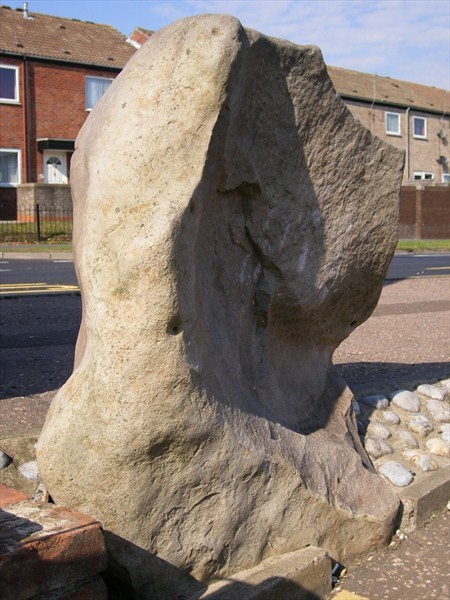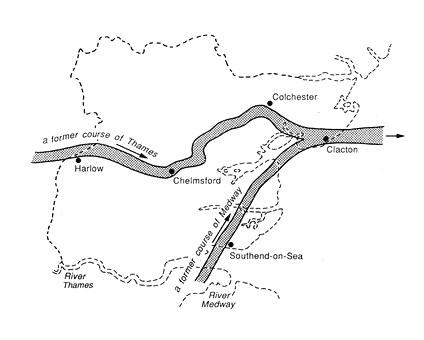The Greenstead Sarsen Stones
Two standing stones in Colchester.
In the suburb of Greenstead, Colchester, two unusual stones stand at the southern end of Avon Way. The co-ordinates will take you to the first of the two sarsen stones, which is standing on the pavement on Avon Way, a second, smaller stone; can be found 249 feet further along Avon Way (N51° 53.134 E000° 56.347). There are many stones scattered around East Anglia. Some were of religious importance to early man and many have myths and legends attached to their location and placement. They may have been placed to mark ancient tracks, boundaries or meeting places. Greenstead housing estate was built in the 1960’s and it is surprising that these stones remain after the building of the housing estate.
 |
 |
| The co-ordinates take you to this stone. |
The second sarsen stone. |
Geology
These two stones are sarsen stones.
The first stone is a large block of sandstone; it consists of quartz grains and is cemented together with silica. If the sun is shining you may be able to see the light glinting off some of the grains within the rock. The stones are a very hard resistant form of sandstone called silcrete, similar to quartzite. Quartzite is a metamorphic rock which was once sandstone but has been changed by heating and pressure. Silcrete forms when silica in a sandstone is dissolved and resolidifies as a cement. This makes the rock very hard. Silcrete often forms in arid regions of the world and probably formed a resistant cap on top of the chalk which covered much of England in the past. The resistant layer of silcrete may have been broken up as ice sheets advanced and retreated in subsequent ice ages. The size of the grains in the stones can tell us about the environment that the sandstone formed in. Large grains in sedimentary rocks indicate they formed in a high energy environment e.g. a fast flowing river, whereas small grains indicate they formed in a low energy environment e.g. in a deep sea. Look at the grains in the stones. What type of environment do you think the sandstones might have formed in? In geological terms the geology of Colchester is young. Colchester stands on the Thames Group, Harwich and London clay formation which is silty clay and sandy clay, this was laid down around 50 million years ago in the Palaeogene period.
How did these rocks end up in Colchester?
These stones were possibly deposited by the early River Thames. Around 450,000-500,000 years ago the River Thames flowed to the north of London through North Essex and Suffolk, the river was a huge braided river flowing across a wide flood plain between Harlow and Colchester(see map below).

Possible route of the River Thames in the past.
It is thought the River Thames diverted south following an ice blockage during the Anglian Glaciation. Evidence of this is the Wigborough gravels found at nearby Great Wigborough, Kesgrave sands and gravels and the superb exposures of Thames/Medway gravel which can be seen in the cliffs at nearby SSSI Cudmore Grove on Mersea Island (TM 068 146). These old Thames gravels contain a variety of pebbles and stones from as far away as North Wales. This indicates that at that time the River Thames may have been a huge river coming from the Welsh Mountains. The gravel contains large boulders of puddingstone (many of these large boulders are scattered across East Anglia) and sarsen stones. Another possibility is that these stones are relics of the last ice age. At that time an ice sheet covered most of Suffolk and North Essex. As the ice advanced it would have eroded the ground over which it passed. These stones may have been deposited as the ice retreated. The heelstone and circle uprights of Stonehenge are built from a similar type of sarsen stone.
Avon Way is a fairly busy road with many buses and because of this there is no parking on Avon Way, but there are many side roads nearby that would be suitable for parking.
Congratulations to PuReWaRRioR69 and Lennyemmy for FTF!!!
Please email me the answers to the following questions to claim this as a find:
1. This stone is made of mineral grains. Name the mineral?
2. What size are the grains 1mm or less, between 1-5mm or between 5-10mm? Do you think the sandstones formed in a low, intermediate or high energy environment?
3. This stone has been ‘weathered’ over the years by rain and alternating cold and warm temperatures and this gives it its colour. What colour or colours is the stone and what is it's texture?
In keeping with recent changes to Earthcache rules, photographs are now optional and I cannot require these to be posted. A photo speaks a thousand words though, so if you have a nice photo of any combination of you, your GPSr and the stones I hope you will choose to post one to the cache page anyway!
Please email me the answers to questions 1, 2, and 3 and post your photo in your log. Please do not post the answers to questions 1, 2, and 3 in your log. Logs with this information in will be deleted.